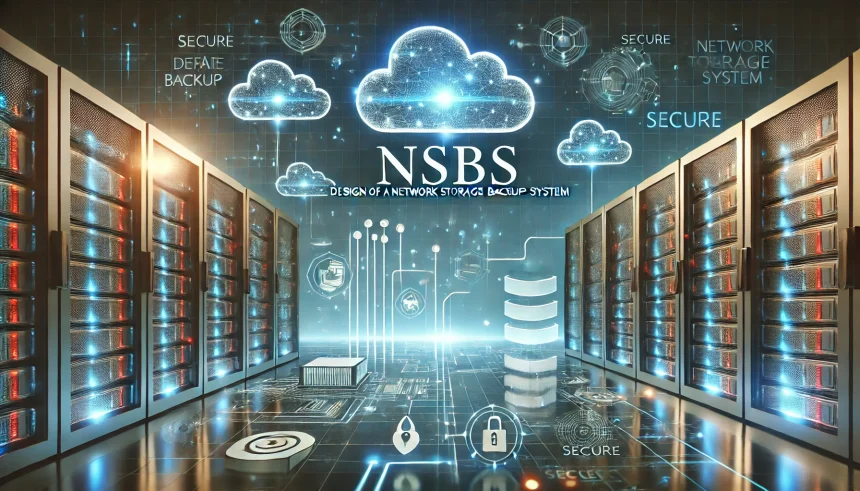A Network Storage Backup System (NSBS) is a structured method of storing and securing data across a network. It ensures that critical files are backed up and can be restored in case of accidental loss, cyber threats, or system failures.
Data is one of the most valuable assets for businesses and organizations. Losing it can lead to financial losses and operational disruptions. That’s why designing an efficient NSBS: Design of a Network Storage Backup System is essential for long-term data security.
The purpose of a network storage backup system is to provide data protection, fast recovery, and scalable storage solutions. It helps organizations maintain smooth operations even in the event of unexpected failures.
Backup systems can be designed using various storage options, such as local storage, cloud-based storage, or hybrid models. Each of these options has different benefits depending on the business’s needs.
A well-designed NSBS follows best practices, including regular backups, encryption, and disaster recovery planning. This ensures that data remains accessible and secure at all times.
Understanding Network Storage Backup
A network storage backup system is a method of storing copies of important data across a network. These backups can be accessed and restored whenever needed, preventing data loss.
The main goal of NSBS is to create a reliable backup process that ensures data integrity. It protects against issues such as hardware failures, accidental deletions, and cyber threats.
Key Features of Network Storage Backup
- Automated Backups: Reduces human errors by scheduling regular backups.
- Data Encryption: Ensures data security during storage and transmission.
- Remote Accessibility: Users can restore data from different locations.
- Scalability: Can expand storage capacity as data grows.
Many organizations use backup software to automate and manage the backup process efficiently. This software helps streamline storage management and reduces operational costs.
By implementing a strong NSBS: Design of a Network Storage Backup System, businesses can reduce risks and increase data protection efficiency. This leads to a more secure and resilient IT infrastructure.
Backup Strategies in NSBS
A backup strategy is a structured approach to saving and restoring data. The right strategy depends on the data size, frequency of changes, and recovery needs.
One of the most commonly used backup methods is the full backup, where all data is copied and stored. This provides a complete data recovery option but requires more storage space.
Incremental backups only save the data that has changed since the last backup. This method reduces storage space and speeds up the backup process. However, restoring data may take longer because multiple backups need to be combined.
Another method is differential backup, which saves all changes made since the last full backup. It is faster than a full backup but requires more space than an incremental backup.
Many organizations use a combination of backup strategies to balance efficiency and storage use. The best approach is to analyze business requirements and choose a strategy that ensures quick recovery while minimizing costs.
Types of Network Storage for Backup
There are different types of network storage that can be used for backup purposes. Choosing the right one depends on budget, data size, and business needs.
Direct-Attached Storage (DAS) connects storage devices directly to a computer or server. It provides fast performance but lacks network-based accessibility, making it suitable for small setups.
A more flexible option is Network-Attached Storage (NAS). This system connects storage devices over a network, allowing multiple users to access backups easily. NAS is a good option for businesses that require centralized data storage.
For enterprises needing high-performance storage, Storage Area Networks (SAN) provide fast and secure data transfer. SANs use dedicated high-speed connections, making them ideal for organizations with large-scale backup needs.
Cloud-based backup solutions are becoming increasingly popular. They offer offsite storage, automated backups, and remote access, making them a great choice for businesses looking for flexible and scalable solutions.
When designing an NSBS: Design of a Network Storage Backup System, organizations must evaluate the pros and cons of each storage type to select the best solution for their needs.
Designing an Effective NSBS
The design process of a network storage backup system involves careful planning to ensure reliability, security, and efficiency. The first step is determining storage architecture, whether it will be centralized, distributed, or cloud-based.
One of the key considerations in NSBS design is the backup frequency and scheduling. Businesses should set up automated daily, weekly, or real-time backups based on the importance of their data.
Key Elements in NSBS Design
- Data Redundancy: Using RAID configurations to prevent data loss.
- Encryption: Protecting data from unauthorized access.
- Scalability: Ensuring the system can handle future data growth.
- Disaster Recovery Planning: Preparing for unexpected failures.
Security is another important factor. Backup systems should use multi-layered security protocols, including authentication, encryption, and firewalls to prevent cyber threats.
By implementing best practices, organizations can build an NSBS: Design of a Network Storage Backup System that is resilient, scalable, and capable of handling large volumes of data efficiently.
Disaster Recovery Planning
Disasters such as hardware failures, cyberattacks, or natural events can cause data loss. A disaster recovery plan ensures that backups can be restored quickly, minimizing downtime.
Organizations should define their Recovery Point Objective (RPO) and Recovery Time Objective (RTO). RPO refers to the maximum acceptable data loss, while RTO defines how quickly data needs to be restored.
Offsite backup solutions provide extra protection in case the primary backup location is compromised. Many companies use cloud-based disaster recovery services for additional security.
Important Disaster Recovery Steps
- Regular backup testing to ensure that stored data is recoverable.
- Using multiple storage locations for enhanced reliability.
- Monitoring systems to detect potential failures early.
Without a disaster recovery plan, even a well-designed NSBS may fail to prevent permanent data loss. Regular testing and updates to the plan are essential for long-term success.
Scalability and Future Considerations
As data continues to grow, NSBS systems must be scalable to meet increasing storage demands. Businesses should choose solutions that allow for easy expansion without major system overhauls.
Cloud storage provides flexibility and cost-efficiency by allowing companies to scale up or down based on their needs. Many organizations are now shifting toward hybrid storage models that combine local and cloud storage.
Emerging Trends in NSBS
- AI-powered backup management for smarter automation.
- Blockchain technology for securing data integrity.
- Edge computing for faster, localized backup solutions.
Future-proofing NSBS: Design of a Network Storage Backup System requires continuous upgrades and improvements. Investing in advanced security, automation, and scalable infrastructure ensures long-term efficiency.
Conclusion
A well-structured NSBS: Design of a Network Storage Backup System is essential for businesses to prevent data loss and ensure fast recovery. A strategic approach helps organizations manage and protect their data effectively.
Selecting the right backup strategy and storage type plays a key role in system efficiency. Whether using on-premise storage, cloud solutions, or hybrid models, businesses must consider security and scalability.
Disaster recovery planning ensures that backup data remains accessible in case of failures. Organizations should regularly test and update their backup systems to keep them effective.
With advancing technologies like AI, blockchain, and cloud storage, backup systems are becoming smarter and more reliable. Businesses should stay updated on emerging trends to enhance their data protection strategies.
By designing a robust NSBS, companies can achieve long-term security, operational stability, and business continuity.
FAQs
What is NSBS and why is it important?
NSBS (Network Storage Backup System) is a structured system for storing and securing data over a network, ensuring quick recovery in case of data loss.
Which backup strategy is best for a business?
A combination of full, incremental, and differential backups is best, depending on data size, storage capacity, and recovery speed requirements.
How does cloud storage improve NSBS?
Cloud storage provides offsite backups, automated scheduling, and scalability, making it ideal for businesses that require flexibility and remote data access.
What security measures should NSBS have?
Essential security features include encryption, multi-factor authentication, access controls, and firewalls to protect against cyber threats.
How often should an NSBS be tested?
Businesses should test backup systems at least quarterly to ensure data integrity, successful recovery, and compliance with disaster recovery plans.
















